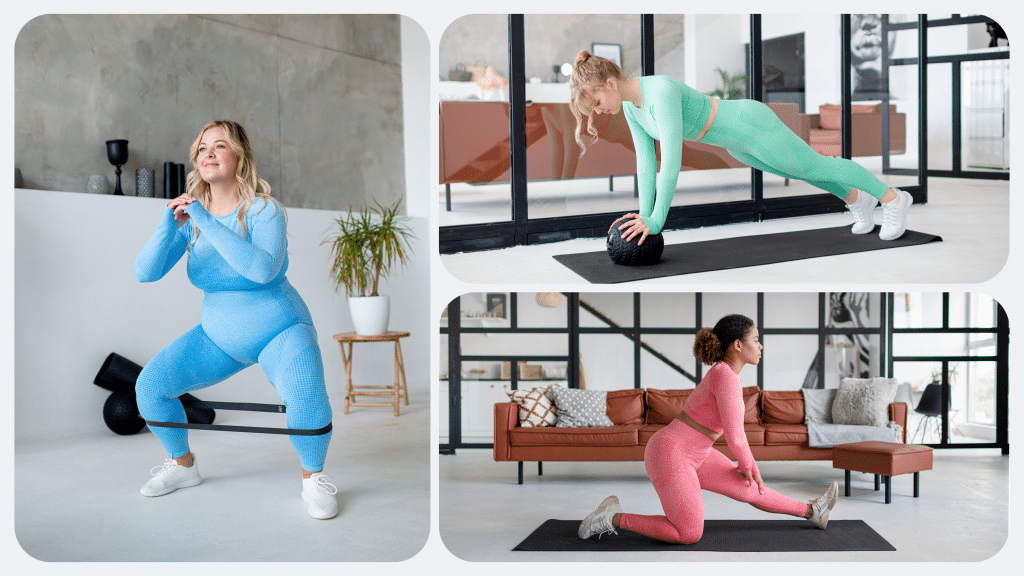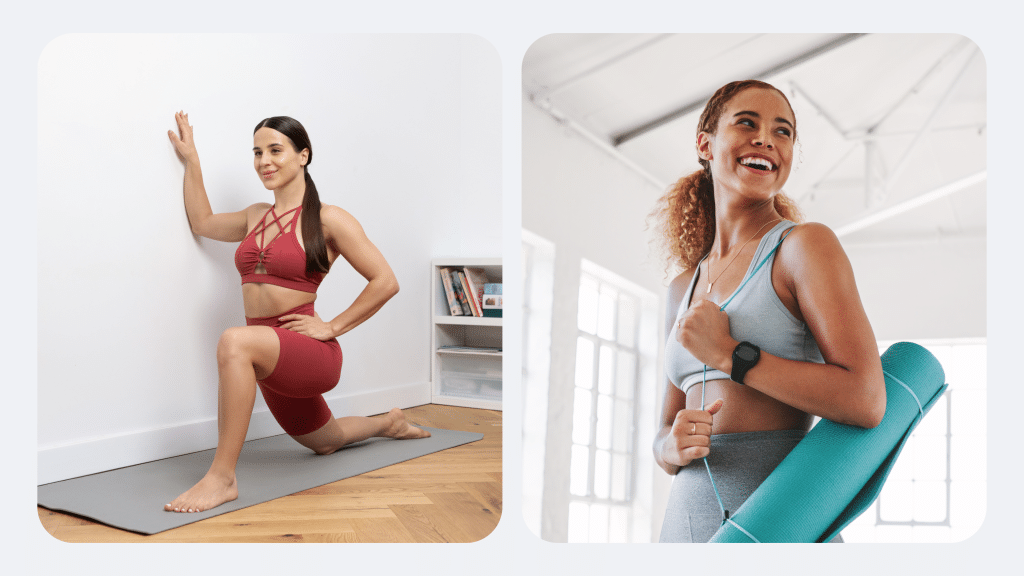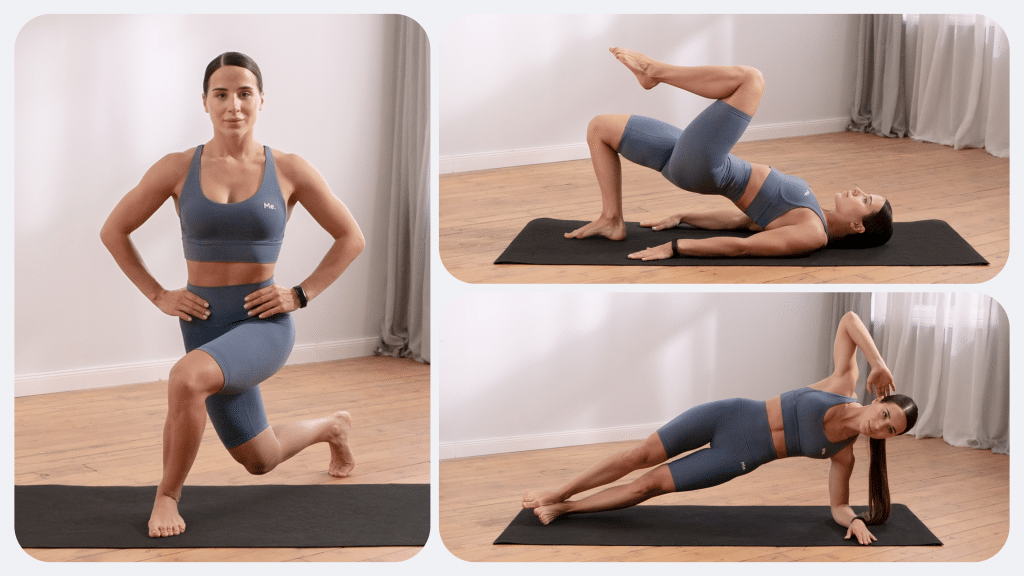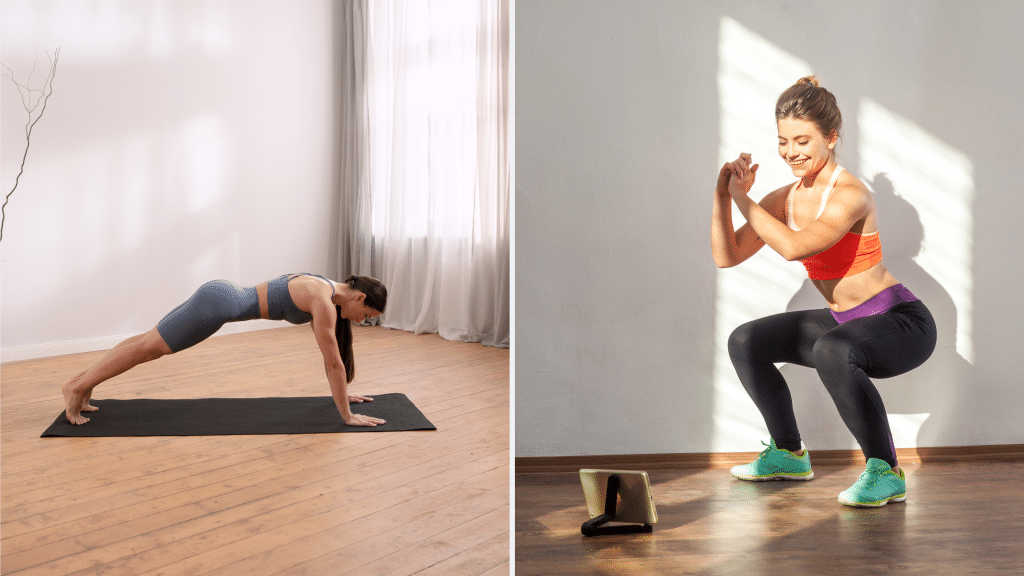We’ve all been there. You join a class at the gym, go for a nice run, or try out the latest workout trend, feeling motivated and excited to get fit. But after a few weeks, your initial excitement fades away and you start skipping workouts, making excuses and eventually giving up on your fitness goals.
Sound familiar?
One of the main reasons people struggle to stick with a workout routine is not having a plan in place. Without a clear plan and structure, it’s easy to lose motivation and fall off track. That’s why creating a well-rounded workout plan is crucial for long-term success.
If you’ve never made a workout plan before, the idea can be overwhelming. Where do you even begin? Don’t worry – we’ve got you covered. Follow these 7 steps to create a workout plan that will help you reach your fitness goals and stay motivated along the way.
What Are the 7 Steps to Creating a Workout Plan?
The 7 steps to creating a workout plan have everything to do with effectiveness. You want to use your time wisely, so you can get the most out of every workout. You also want to enjoy your workouts, so you stick with them in the long term. Here are the 7 steps to creating a workout plan:
Step 1: Goal Setting for Success
Setting goals is the cornerstone of any successful workout plan. Without clear objectives, it’s easy to drift aimlessly, struggling to find motivation.
Goals provide direction and purpose, which makes each workout session meaningful. When these goals are specific, measurable, achievable, relevant, and time-bound (SMART), they become even more powerful. SMART goals serve as a roadmap, helping you track progress and make necessary adjustments along the way.
Scientific studies have shown that people who set specific goals are more likely to succeed. Why? Because specific goals break down the overwhelming task of getting fit into manageable actions.
For example, instead of saying “I want to get fit”, you might say “I want to be able to run 5 kilometers in under 30 minutes within the next three months”. This clarity increases motivation and also provides criteria to measure success.
Now, let’s get practical. Here’s how you can set effective fitness goals:
- Identify Your Motivation: Understand why you want to embark on this journey. Is it to improve your health, reduce stress, or boost your confidence? Knowing your ‘why’ fuels your drive.
- Define Clear Objectives: Outline what you want to achieve. Whether it’s weight loss, muscle gain, or increased endurance, be clear about the outcome you desire.
- Break Down Big Goals: Large goals can be daunting. Divide them into smaller, achievable milestones. This makes the process less intimidating and more rewarding as you tick off each milestone.
- Establish a Timeline: Deadlines create urgency and help maintain focus. Set a realistic timeframe for each goal, accounting for any potential setbacks.
- Write Them Down: Putting your goals on paper makes them tangible. It serves as a constant reminder of what you’re working toward.
- Track Your Progress: Regularly review your goals and assess your progress. This helps you stay on track and make necessary adjustments.
- Celebrate Small Wins: Acknowledge and celebrate each milestone achieved. This boosts morale and keeps you motivated for the next challenge.
Step 2: Decide Your What, When and How
First, decide what type of exercise suits your goals. Are you aiming to build strength, improve endurance, or enhance flexibility? Each goal requires a different approach.
For example, strength training is ideal for building muscle (1), while cardio exercises such as running or cycling improve cardiovascular health (2). Flexibility and balance can be enhanced through yoga or Pilates.
Choosing the right type of exercise ensures that your efforts are effective and aligned with your objectives.
Next, figure out when you can consistently fit workouts into your schedule. Consistency is the key to achieving fitness success. Whether you’re a morning person or prefer evening workouts, it’s important to choose a time you can stick to regularly.
Whether you’re a workout beast or just a beginner making your first foray into the world of fitness and dieting – BetterMe has a lot to offer to both newbies and experts! Install the app and experience the versatility first-hand!
Research has suggested that exercising at the same time each day can help create a habit, which makes it easier to maintain long-term commitment (3).
Finally, decide how you will approach your workouts. This involves determining the structure and intensity of each session. Will you focus on high-intensity interval training (HIIT), steady-state cardio, or perhaps a mix of different methods?
Consider your fitness level and experience when making this decision. Starting with a manageable intensity and gradually increasing it can help prevent burnout and reduce the risk of injury (4).
Here’s a direct list of steps to guide you:
- Assess Your Fitness Level: Understand your current fitness capabilities. This will help you choose exercises that are challenging yet achievable.
- Consider Time Availability: Look at your schedule and identify time slots when you can consistently work out. Consistency breeds success.
- Select Appropriate Exercises: Choose exercises that are aligned with your fitness goals. Mix different types to ensure a well-rounded routine.
- Plan Your Workout Schedule: Decide on the frequency of your workouts. Balance is the key – aim for a mix of strength, cardio, and flexibility exercises throughout the week.
- Determine Workout Intensity: Choose a level of intensity that suits your fitness level. Gradually increase the intensity as you get stronger and more comfortable.
- Stay Flexible: Life can be unpredictable. Allow some flexibility in your plan to accommodate unexpected changes without losing momentum.
Read more: Weight Loss Programs For Women: Drop Pounds And Maintain The Result Over The Long-Haul
Step 3: Familiarize with Exercise Science
There’s a lot of misinformation surrounding fitness and exercise, so it’s important to educate yourself on the science behind what makes a workout effective. Understanding exercise principles can help you avoid common mistakes and maximize results.
Key concepts in exercise science include progressive overload, specificity, rest and recovery, and periodization (5).
Progressive overload is the gradual increase of stress placed on the body through exercise over time (6). This allows for continuous improvement as your body adapts to new challenges.
Specificity, or the principle of training specificity, states that you must train specific muscles or systems in order to see improvements in those areas (5).
For example, if you want to improve your running performance, you must train with running rather than exclusively doing strength exercises.
Rest and recovery are essential for muscle growth and injury prevention (7). Giving your body time to recover and repair after workouts is important for achieving fitness goals.
Periodization is the systematic planning of training cycles to peak at specific times, such as before a competition or event (8). This helps prevent overtraining and allows for sustained improvement.
There are also some myths and misconceptions regarding exercise that you should be aware of, such as:
- Spot reduction: The belief that you can target specific body parts for fat loss through exercise. In reality, fat loss occurs throughout the body as a whole.
- No pain, no gain: Pushing yourself too hard and ignoring your body’s signals can lead to injury. It’s important to find a balance between challenging yourself and listening to your body’s limits.
- Lifting weights will make women bulky: Women don’t have the same hormonal makeup as men, so it’s almost impossible for them to bulk up like bodybuilders without specifically training and eating for that goal, as well as the right genetics.
- Exercise can cancel out a bad diet: While regular exercise is important for overall health, it can’t make up for an unhealthy diet (9). Nutrition and exercise go hand in hand for optimal results.
There are many more principles and myths in exercise science that are worth exploring. The more you understand about the science behind fitness, the better equipped you’ll be to create an effective workout plan.
Step 4: Review Your Nutrition Needs
A well-rounded fitness routine goes beyond just exercise. Nutrition plays a crucial role in supporting your body’s physical activity and overall health. It’s important to fuel your body with the right nutrients to support energy levels, muscle growth and repair, and overall performance (10).
Here are some key nutrition considerations for fitness:
- Calories: Your calorie intake should match your energy expenditure to maintain weight, or create a deficit to lose weight (11). Consult a healthcare professional or registered dietitian to get personalized advice.
- Macronutrients: Protein, carbohydrates, and fats are essential macronutrients that provide the building blocks for your body to function properly (12). Make sure you’re getting enough of each in your diet.
- Micronutrients: Vitamins and minerals are micronutrients that support various bodily functions (13). Eating a diverse range of fruits, vegetables, whole grains, and lean proteins can help ensure you’re getting all the essential micronutrients.
In addition to these general guidelines, it’s important to listen to your body and make adjustments as required. Fueling properly before and after workouts can also improve performance and recovery.
Step 5: Review What You Need to Get Started
Before you jump into your new fitness routine, it’s important to make sure you have all the tools and resources you need.
Here are some items to consider adding to your gym bag or home workout space:
- Comfortable and supportive athletic shoes
- Appropriate workout attire (comfortable and breathable)
- Resistance bands or weights for strength training
- A yoga mat or towel for floor exercises
- Water bottle to stay hydrated during workouts
- A journal or tracking app to keep track of progress and goals
Step 6: Start Slow and Gradually Increase
It’s important to listen to your body and start slow, particularly if you’re new to exercise. This gives your body time to adapt and prevent injury.
Here are some tips for starting a new fitness routine:
- Start with low-intensity exercises and gradually increase as you feel more comfortable.
- Take breaks when needed and don’t push yourself too hard.
- Incorporate rest days into your schedule to allow for proper recovery.
Step 7: Give Yourself at Least Six Weeks
Results take time and consistency. Don’t be discouraged if you don’t see immediate changes. Stick with your routine for at least six weeks before you evaluate your progress and make adjustments.
Some adjustments that can be made after six weeks include increasing intensity, changing up your exercises, or adjusting your nutrition plan.
What Is the Most Successful Workout Split?
The most successful workout split is one that fits your individual goals, schedule, and abilities. It’s important to find a routine that you enjoy and can stick to consistently.
Some popular workout splits include:
- Full body workouts: These involve working all major muscle groups in one session, typically done 2-3 times per week.
- Upper/lower split: Dividing workouts into upper body and lower body days, usually done 4 times per week.
- Push/pull/legs split: This involves separating exercises by pushing movements (e.g. chest press), pulling movements (e.g. rows), and leg exercises, typically done 3-4 times per week.
Ultimately, the best workout split is one that allows for adequate rest and recovery, includes a variety of exercises, and is aligned with your specific goals. Consulting a fitness professional can also help create an effective workout split tailored to your needs.
BetterMe: Health Coaching app helps you achieve your body goals with ease and efficiency by helping to choose proper meal plans and effective workouts. Start using our app and you will see good results in a short time.
How to Make a Weekly Workout Plan?
Follow the 7-step guide outlined in this guide to create a personalized weekly workout plan. Some key considerations include:
- Setting specific, achievable goals
- Choosing exercises that are aligned with your goals and abilities
- Incorporating different types of workouts (e.g. cardio, strength training, flexibility)
- Periodizing your training for optimal results
- Paying attention to nutrition needs and making adjustments as needed
- Starting slow and gradually increasing intensity
- Giving yourself at least six weeks before evaluating your progress and making adjustments
Here’s a sample weekly workout plan to give you an idea of how it may look:
- Monday: Full-body strength training with weights
- Tuesday: Rest day or low-intensity cardio (e.g. walking, cycling)
- Wednesday: Upper-body strength training and core exercises
- Thursday: Rest day or yoga for flexibility and mobility
- Friday: Lower-body strength training and HIIT (high-intensity interval training) cardio
- Saturday: Active rest day with outdoor activities (e.g. hiking, swimming)
- Sunday: Rest day or light yoga/stretching.
Read more: 6 Fitness Challenges To Try Before 2024 Ends
How Do I Choose a Workout Program?
Should you decide to follow a workout program, here are some things you should consider in your selection process:
- Your goals and abilities: Make sure the program is aligned with what you want to achieve and is suitable for your physical abilities.
- Time commitment: Choose a program that fits into your schedule realistically. Be honest with yourself about how much time and effort you can dedicate.
- Variety: Look for programs that offer a mix of exercises and training styles to keep things interesting and prevent boredom or plateaus.
- Progression: A good workout program should have built-in progressions (e.g. gradually increasing weight, reps, or intensity) to continually challenge your body.
- Reputable source: When choosing a workout program, make sure it’s from a reputable source such as a certified personal trainer or fitness professional.
Remember that the best workout program is one that you enjoy and can stick to consistently. Don’t be afraid to try out different programs until you find one that works for you.
To structure your workout plan, start by setting clear fitness goals, such as building muscle, increasing endurance, or losing weight. Decide on the frequency of workouts each week, ensuring a balance of strength, cardio, and flexibility exercises. Choose exercises that target major muscle groups and vary the intensity and duration to match your fitness level. Incorporate rest days to allow for recovery and prevent overtraining (7). A 6-day split can be effective for experienced individuals who are aiming for advanced fitness goals, such as bodybuilding. However, it may be too intense for beginners or those with limited recovery abilities. It’s important to monitor your body’s response and adjust accordingly, ensuring adequate rest and recovery to prevent burnout or injury. The 4-2-1 workout split involves four days of weight training, two days of cardio, and one rest day per week. This split is designed to balance muscle building with cardiovascular fitness, offering variety and allowing for recovery while maintaining consistent physical activity. A workout should typically last between 30 to 60 minutes, depending on the type and intensity of exercise. Shorter, high-intensity workouts can be effective for cardiovascular improvement and fat loss, while longer sessions may be necessary for endurance training or comprehensive strength workouts. Generally, 1 to 2 rest days per week are recommended to allow your muscles to recover and grow, prevent fatigue, and reduce the risk of injury. The exact number of rest days you take will be dependent on your fitness level, goals, and the intensity of your workouts. Significant weight loss or body slimming in one week is unlikely and not advisable due to health risks. Sustainable weight loss involves a caloric deficit that is achieved through a balanced diet and regular exercise over time (14). Quick fixes may result in temporary changes and potential negative health effects (15).Frequently Asked Questions
How do I structure my workout plan?
Is a 6-day split too much?
What is the 4-2-1 workout split?
How long should a workout be?
How many rest days should I have per week?
Can I get slim in 1 week?
The Bottom Line
Exercise science provides valuable knowledge and principles for creating an effective fitness routine.
By understanding the importance of rest and recovery, incorporating periodization, avoiding exercise myths, fueling yourself properly with nutrition, gathering necessary resources, starting slow and gradually increasing intensity, giving yourself enough time to see results, and finding the best workout split for you, you can set yourself up for success in achieving your fitness goals.
DISCLAIMER:
This article is intended for general informational purposes only and does not serve to address individual circumstances. It is not a substitute for professional advice or help and should not be relied on for making any kind of decision-making. Any action taken as a direct or indirect result of the information in this article is entirely at your own risk and is your sole responsibility.
BetterMe, its content staff, and its medical advisors accept no responsibility for inaccuracies, errors, misstatements, inconsistencies, or omissions and specifically disclaim any liability, loss or risk, personal, professional or otherwise, which may be incurred as a consequence, directly or indirectly, of the use and/or application of any content.
You should always seek the advice of your physician or other qualified health provider with any questions you may have regarding a medical condition or your specific situation. Never disregard professional medical advice or delay seeking it because of BetterMe content. If you suspect or think you may have a medical emergency, call your doctor.
SOURCES:
- Strength training: Get stronger, leaner, healthier (2023, mayoclinic.org)
- Aerobic Exercise: What It Is, Benefits & Examples (2023, my.clevelandclinic.org)
- Consistent Morning Exercise May Be Beneficial For Individuals with Obesity (2021, ncbi.nlm.nih.gov)
- Exercise intensity (2024, betterhealth.vic.gov.au)
- Principles of Exercise (n.d., physio-pedia.com)
- Progressive overload without progressing load? The effects of load or repetition progression on muscular adaptations (2022, ncbi.nlm.nih.gov)
- Why Rest Days Are Important for Muscle Building (n.d., blog.nasm.org)
- CURRENT CONCEPTS IN PERIODIZATION OF STRENGTH AND CONDITIONING FOR THE SPORTS PHYSICAL THERAPIST (2015, pmc.ncbi.nlm.nih.gov)
- The truth about exercise and eating junk food! (2022, healthdirect.gov.au)
- Sport and exercise (n.d., nutrition.org.uk)
- Understanding calories (2023, nhs.uk)
- Nutrition: Macronutrient Intake, Imbalances, and Interventions (2023, ncbi.nlm.nih.gov)
- Nutrition: Micronutrient Intake, Imbalances, and Interventions (2023, ncbi.nlm.nih.gov)
- Weight loss – a healthy approach (2024, betterhealth.vic.gov.au)
- Risks Associated With Excessive Weight Loss (2024, ncbi.nlm.nih.gov











